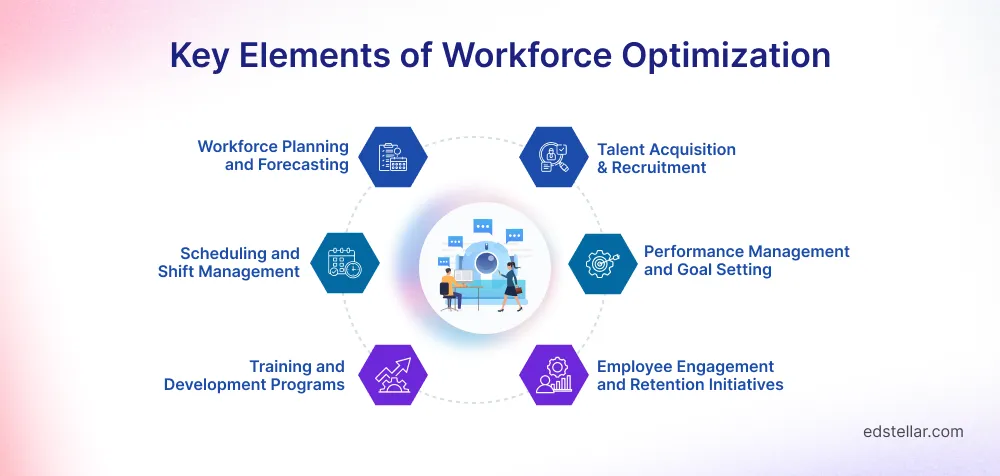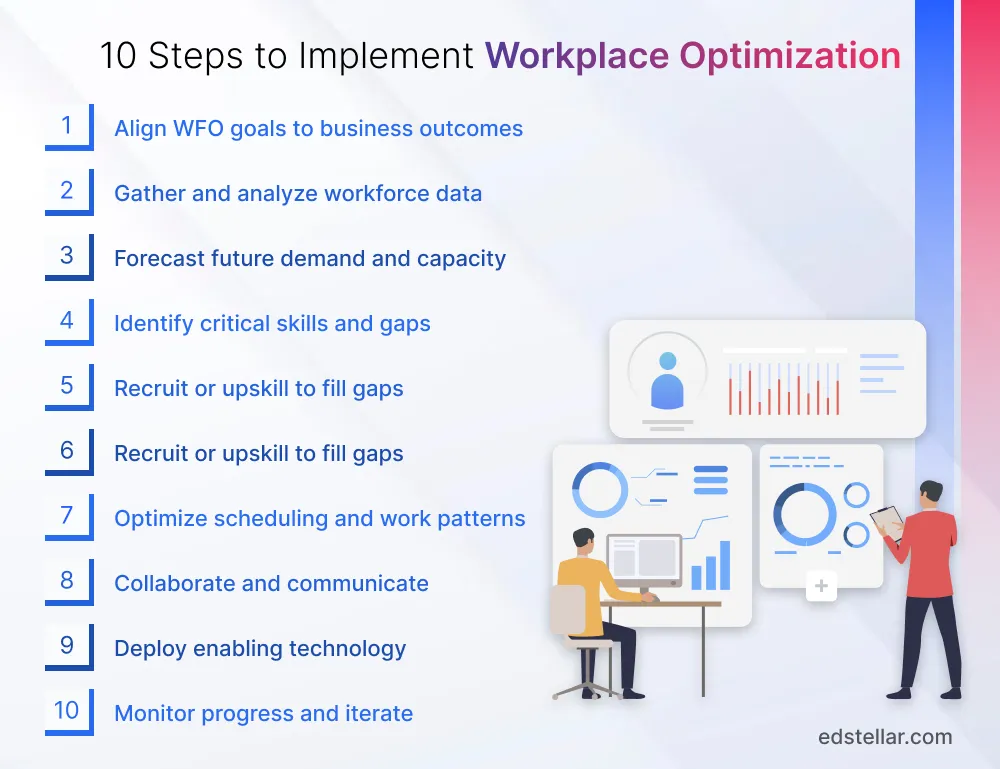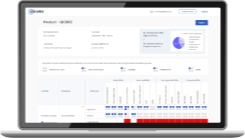
Organizations today face constant pressure to innovate, improve operations and adapt quickly to new market realities. Organizations are forced to rely on processes that help them not only hire great talent but also ensure that talent works together effectively. It's about ensuring that every team, role, and process is aligned with the company’s goals, so that the right people are in the right place, at the right time, with the right skills.
But that is easier said than done. According to Gartner, 78% of CEOs report critical skills gaps, and 57% of HR managers say skills deficiencies undermine their capacity to sustain corporate performance. To bridge these gaps, organizations must adopt workforce optimization strategies (WFO) that not only address skill shortages but also ensure the efficient alignment of talent with business objectives, driving both short-term and long-term success.
Companies adopting WFO best practices report unusually high employee engagement (over 70% of staff actively engaged in their work), and happier employees are 13% more productive.
Poor staffing can hurt the business: 32% of customers say they will abandon a brand they love after just one bad experience, underscoring how crucial well-trained, properly scheduled employees are to customer satisfaction.
Industry experts stress this point: as one guide observes, WFO is about making your people and processes the best they can be, “an environment where neither time nor talent is wasted,” as Tim Copeland of Runn puts it. When done right, WFO strategies maximize productivity, improve employee satisfaction, and enhance the customer experience.
These insights capture why WFO is a top priority for all industries today.
This guide defines workforce optimization, breaks down its key components and implementation steps, highlights effective tools, and discusses how to measure success, equipping you to build a truly optimized workforce in your organization.
What Is Workforce Optimization?
Workforce optimization is the strategic alignment of people, skills, processes, and time to achieve business goals. By optimizing how talent is allocated across projects, measuring performance through key metrics, and continuously refining workflows, organizations can bridge skills gaps, enhance efficiency, and drive sustainable success.
The precise definition can vary, but experts converge on the idea of using planning, analytics, and management to boost efficiency and cut costs. This isn’t just about trimming staff; it’s about fine-tuning hiring, scheduling, and work processes. WFO first became popular in contact centers, where it merged traditional workforce management with quality monitoring. However, its applications have since expanded across nearly every business function, from marketing to finance.
When fully executed, workforce optimization delivers clear benefits: it reduces operational costs, enhances efficiency, and boosts productivity. In other words, companies waste less (through reduced overtime and idle time) and get more output (through better-trained, engaged people).
To quote McKinsey, talent + productivity = value.
A successful WFO maximizes the value and ROI of your workforce, also known as Return on Talent.
In sum, workforce optimization blends careful planning (forecasting demand and scheduling) with performance management, training, and continuous improvement to achieve leaner, more agile operations.
Key Elements of Workforce Optimization
Workforce optimization is multi-faceted. The core elements include all the usual HR and operations building blocks, knitted together strategically. The most important components are:

- Workforce Planning and Forecasting: Anticipating future staffing needs based on business projections, seasonal trends, and growth targets. Effective WFO begins by forecasting demand (e.g., customer call volumes, production targets, or project workloads) and then planning how many people, with which skills, will be needed. Rather than guesswork, this uses data-driven models.
- Talent Acquisition & Recruitment: Having the right hiring and onboarding processes to bring in skills where gaps are predicted. WFO isn’t just planning, it’s also filling roles. Teams implement targeted recruiting so that open positions are filled with candidates who have the competencies forecasted in planning. Good WFO means partnering with HR and recruiting to align job requirements with long-term strategy (for example, prioritizing digital or soft skills).
- Scheduling and Shift Management: Creating optimal work schedules that match staffing supply to demand while respecting employee availability. After determining how many people are needed, the next step is to schedule them. Tools like workforce management (WFM) software can automate this, but the principle is to cover all critical shifts, plan for peaks, and minimize both overstaffing (wasting money) and understaffing (hurting service or production).
- Performance Management and Goal Setting: Continuously measuring employee output, giving feedback, and aligning goals to company objectives. Once people are in place, WFO involves regularly reviewing how well they do. This includes setting clear performance targets (e.g., KPIs), monitoring outcomes, and coaching where needed. Positive recognition and rewards keep motivation high.
Companies may use productivity dashboards or performance appraisal systems as part of this. Effective performance management ensures that each individual’s work contributes to optimization. For example, if metrics show an agent’s calls are taking too long, targeted coaching or training can be provided to improve efficiency. In essence, this element turns WFO into a feedback loop: performance data is used to refine planning and training.
- Training and Development Programs: Investing in employee skills so that the workforce can meet changing role requirements. Even the best plans fail if people lack the necessary competencies. WFO, therefore, includes structured training. This can be technical upskilling (new software, machinery, etc.), soft skills (communication, problem-solving), or leadership coaching.
- Employee Engagement and Retention Initiatives: Ensuring that employees feel motivated and committed so they stay and perform well. Finally, WFO recognizes that an engaged workforce is more efficient. When people are involved, heard, and recognized, they are more productive. Conversely, disengagement leads to absenteeism and turnover, which hurt optimization. Thus, companies incorporate surveys, feedback channels, career pathing, and wellness programs into their WFO strategy.
In practice, these elements work together: planning tells you who to hire and train; scheduling tells you when to use them; performance management and engagement tell you how well it’s working.
Each organization will weigh these differently, but none can be ignored. The key is that workforce optimization is holistic: it combines quantitative planning with human-centric practices (hiring the best candidates, training them, and keeping them engaged) to run a high-performing enterprise.
Steps to Implement Workforce Optimization
Companies putting talent at the center of strategy enjoy much higher returns. For instance, top-performing firms generate up to 300% more revenue per employee than the median. WFO aims to get the right people with the right skills in the right place at the right time, at the right cost.

Below are the key steps to roll out WFO. Adopting a consultative, data-driven approach will help you avoid the pitfalls of generic “checklist” planning and focus on what your organization needs.
- Align WFO Goals to Business Outcomes: e.g., reducing labor costs, improving customer service, or supporting new products, with specific targets (50% of goals should be SMART and quantifiable).
- Gather and Analyze Workforce Data: Integrate sources like historical workloads, staffing levels, skills inventories, and financial constraints. Note that most companies are not doing this well. A Deloitte survey found that 83% of organizations have only low analytics maturity for their workforce data.
- Forecast Future Demand and Capacity: Use data (and scenario planning) to project headcount by role or shift under different business scenarios. Factor in productivity targets and seasonality. Strategic planners often take a 3–5 year view so they can have the right number of people with the right skills at the right time.
- Identify Critical Skills and Gaps: Compare future needs to current capabilities. Determine where you have shortages (or surpluses) of people and, crucially, where skills are lacking. A seminal workforce planning guide stresses that WFO isn’t just about numbers but also skills, knowledge, and experience. (For example, one study found productivity losses from skill gaps and disengagement can cost an average large company ~$480 million per year.)
- Recruit or Upskill to Fill Gaps: Once gaps are clear, take action. This may mean hiring new talent for future roles, and/or training current employees. CIPD experts note that effective workforce planning “should lead to action. Recruitment and workforce development, delivered through education, training, are the two most obvious action areas. By 2030, 59% of workers will need training; 29% upskilled in their current roles, 19% reskilled for new positions, and 11% at risk without upskilling, highlighting workforce optimization’s critical role in preventing skills gaps.
- Optimize Scheduling and Work Patterns: With headcount and skills in place, match staffing to demand. Adopt workforce‐management tools (or proven processes) to build shift rosters that cover peaks without excess overtime. Flexible shift patterns and self-service scheduling can dramatically improve efficiency: for instance, one contact‐center WFM deployment cut overtime 25% and slashed manual planning time by 87%. In another case, improving schedules drove an 80% reduction in overtime costs. Good scheduling not only saves money but also boosts service (the right number of staff reduces customer wait times) and employee morale.
- Empower Managers and Employees: Give leaders and staff the tools and visibility they need. That means dashboards and reports for managers (so they can see KPIs and make timely adjustments), and mobile/self‑service apps for employees (to view schedules, swap shifts, or request time off).
- Collaborate and Communicate: Workforce optimization touches all parts of the business, so don’t work in a silo. Share the plan and listen to stakeholders in HR, finance, ops, etc. For example, WFO needs to operate across the silos in HR and link strongly with planning and finance, involving these teams in design and rollout. Communicate clearly why you’re changing schedules or metrics (e.g., tying them to better work-life balance or customer service) so people buy in. Cross‑functional involvement helps the plan stick and surface ideas (for instance, production leaders might see ways to smooth demand that HR hadn’t considered).
- Deploy Enabling Technology: Use software to automate the heavy lifting. Modern WFO platforms include modules for forecasting demand (even AI‑driven models), dynamic scheduling, time-tracking, and performance analytics. They can alert you to emerging issues (e.g., skills shortages or spikes in absenteeism) in real time. Workforce Research notes that all-in-one… workforce management software can help boost productivity through features like labor forecasting and communication platforms. Likewise, AI and analytics make strategic planning easier, as McKinsey finds companies harnessing AI innovations now plan talent with the same rigor as managing their financial capital. The right tech stack turns data into insight, frees managers from manual tasks, and gives everyone visibility into the plan.
- Monitor Progress and Iterate: WFO isn’t a one‑off project but a cycle. Regularly review key KPIs, for example, labor cost as % of revenue, schedule adherence, service levels, turnover rates, forecast accuracy, etc. Track these at least monthly and compare against your targets. According to CIPD, workforce planning should be followed up with monitoring and evaluation; otherwise, we do not know if actions are being taken and if our situation is getting better or worse.
If a metric drifts off track (say, overtime spikes again), dive in to find why. Then adjust: tweak schedules, re-forecast demand, retrain staff, or reassign resources as needed. Continuous adjustment keeps your workforce agile.
By following these steps, you’ll build a more efficient, adaptable operation. Each piece is backed by real evidence: companies using structured WFO approaches tend to outperform peers (e.g., higher productivity and lower costs), while those neglecting planning expose themselves to big risks.
In short, invest the time up front in WFO and you’ll reap measurable gains in productivity, cost control, and customer satisfaction down the road..
Another key practice is flexibility: offering options like remote work or split shifts, which can pay off in higher engagement and lower turnover. Essentially, treat workforce optimization as an ongoing business transformation, not just an HR exercise.
Tools for Effective Workforce Optimization
Today’s WFO strategies depend heavily on software and technology. There is a wide array of tools that address different elements of the optimization process. Some examples include:
- Workforce Management (WFM) Software: These systems handle scheduling, time and attendance, and often forecasting. Well-known platforms include UKG (Kronos), ADP Workforce Now, Oracle WFM, and NICE (for contact centers). They automate shift assignments based on rules, track real-time attendance, and alert managers to coverage gaps. More advanced WFM tools incorporate forecasting engines that predict staffing needs from historical data, and intra-day management to re-allocate staff on the fly if demand changes. Using such software can eliminate hours of manual scheduling and reduce labor costs significantly.
Below is a comparison of leading WFM platforms and their core capabilities:
- Performance Management & Quality Assurance: WFO platforms increasingly integrate output analytics and QA with scheduling data. For example, leading contact‐center suites (NICE, Verint, Zendesk, etc.) combine workforce metrics (attendance, adherence) with call recording and quality dashboards. Ventana Research notes that modern contact‐center platforms now include workforce and quality management under one roof.
In practice, this means supervisors see an agent’s schedule adherence alongside customer‐satisfaction scores or call‐handling metrics in one interface. Managers can immediately act on deviations, e.g., scheduling extra training when an agent’s CSAT drops, since performance data is tied to staffing. This unified visibility (schedule + quality) accelerates coaching and continuous improvement as part of WFO.
- Analytics & Business Intelligence (BI) Platforms: Visualizing workforce data is critical for optimization. Companies use BI tools (e.g., Tableau, Power BI) to track metrics like turnover, productivity, attendance, and forecast accuracy. Custom dashboards can reveal patterns, such as a “heat map” of absences by department, enabling leaders to identify issues early. While BI platforms focus on historical data analysis, AI-driven workforce management tools are emerging to predict staffing needs, detect skills gaps, and suggest adjustments. These AI-enabled tools can proactively recommend schedule tweaks or identify training needs, empowering HR teams to act swiftly based on real-time analytics.
- Learning Management Systems (LMS) & Training Catalogs: They play a vital role in aligning workforce development with operational goals. LMS platforms like Cornerstone and SAP SuccessFactors help manage, track, and report employee learning at scale, supporting compliance and structured internal delivery. Complementing these systems, training catalogs such as those offered by Edstellar provide the actual content needed to address evolving skill requirements.
Covering technical, behavioral, and leadership areas, these catalogs enable organizations to act quickly when workforce data or assessments highlight capability gaps. When integrated into broader workforce strategies, curated training programs help accelerate upskilling, boost adaptability, and ensure employees are equipped to meet role expectations efficiently. - Employee Engagement & Feedback Apps: Tools like Officevibe, 15Five, or Glint add the human element to WFO. They run frequent pulse surveys, feedback loops, and recognition programs so management can detect low morale or stress early. By soliciting regular feedback, companies can address issues before they spiral. For example, if a pulse survey reveals declining manager support in one team, HR can intervene (extra coaching or a one-on-one session) before turnover rises.
These apps also democratize listening as employees can flag concerns via anonymous surveys. In short, an engagement toolkit shows leaders care about people, not just processes. Research shows that organizations with cultures of continuous feedback see measurably higher retention and performance, so embedding these apps in your WFO stack pays off. - Collaboration & Communication Platforms: With distributed and hybrid work growing, robust comms tools are essential for WFO. Platforms like Slack, Microsoft Teams, or Asana let staff share schedules, chat about tasks, and coordinate in real time. For example, a Teams/Slack bot can enable an employee to swap shifts with a coworker or check the latest roster via chat, reducing scheduling hassles and manager overhead.
Collaboration apps also support file sharing and notifications (e.g., last-minute shift changes). As evidence of the trend, by the end of 2026, roughly 14% of U.S. employees (~36M people) will work from home, making such tools critical. (Currently, Teams has ~320 million monthly users globally versus Slack’s ~65 million.) Embedding these platforms in your WFO ecosystem ensures everyone, on-site or remote, stays aligned on schedules, tasks, and priorities. The result is more transparent communication and a smoother, more empowered workforce..
A comparison of WFO tools might look like this:
Each organization should pick tools that integrate well with its existing systems (HRIS, payroll, etc.) and provide the automation it needs. Many WFO suites even offer all-in-one solutions, for instance, NICE and Verint bundle scheduling, performance, and QA into a single platform for contact centers.
Workday and Oracle HCM are broad suites that cover HR data, so they can be configured for staffing, scheduling, and training. When choosing software, consider whether you need cloud solutions (for remote access), mobile capabilities (for employees on the go), and the level of automation (e.g., auto-scheduling vs manual).
Ultimately, technology is an enabler of workforce optimization. It should empower decision-makers with timely information and free managers from tedious tasks, while giving employees clarity and flexibility. But even the best software is only as good as the processes behind it.
Successful WFO implementations often follow the adage: technology supports strategy, not the other way around. In other words, define your WFO approach first, then pick tools that align with it.
Conclusion
Workforce optimization is not a one-time project but a continuous journey. Organizations that get it right unlock significant advantages: leaner operations, higher employee morale, and happier customers. Today’s digital tools and data analytics make WFO more achievable than ever, but it still depends on sound strategy, good leadership, and ongoing training.
As businesses strive to stay agile, integrating workforce optimization with talent development is key. After all, the best plan fails without skilled people to execute it. This is where comprehensive training solutions come in. For example, Edstellar is a one-stop corporate training and coaching provider, offering 2000+ instructor-led programs across technical, behavioral, management, and leadership domains.
Our platform includes a Skill Matrix to assess employee capabilities and even an AI-driven analytics engine (“Stellar AI”) to highlight development needs. By combining workforce analytics with targeted upskilling, Edstellar’s approach exemplifies the final piece of WFO: ensuring your people are ready for the challenges the plan identifies.
In practice, successful companies tie WFO and upskilling together. They use skill management software to track who can do what, then apply workforce analytics to schedule and train accordingly. This closes the loop: optimization reveals which skills are lacking, and tailored training (from providers like Edstellar) fills those gaps.
In summary, a robust workforce optimization strategy means:
- Planning well (data-driven forecasts and staffing plans).
- Equipping staff (with training, tools, and clear goals).
- Listening and adapting (using metrics and feedback to refine the approach).
When all these pieces come together, organizations create an environment where neither time nor talent is wasted, but fully leverage their greatest asset: their people. Investing in such a holistic WFO strategy and supporting it with platforms like Edstellar’s skill management and training solutions will help your company stay productive, efficient, and competitive today and into the future.
Explore High-impact instructor-led training for your teams.
#On-site #Virtual #GroupTraining #Customized

Bridge the Gap Between Learning & Performance
Turn Your Training Programs Into Revenue Drivers.
Schedule a ConsultationEdstellar Training Catalog
Explore 2000+ industry ready instructor-led training programs.

Coaching that Unlocks Potential
Create dynamic leaders and cohesive teams. Learn more now!


Want to evaluate your team’s skill gaps?
Do a quick Skill gap analysis with Edstellar’s Free Skill Matrix tool

Transform Your L&D Strategy Today
Unlock premium resources, tools, and frameworks designed for HR and learning professionals. Our L&D Hub gives you everything needed to elevate your organization's training approach.
Access L&D Hub Resources.svg)
.svg)



.svg)

.svg)
.svg)
.svg)
.svg)

